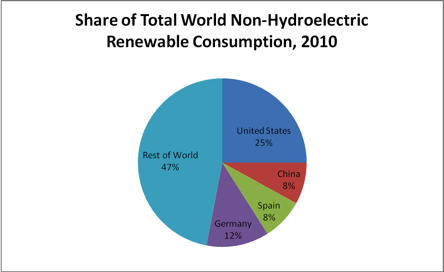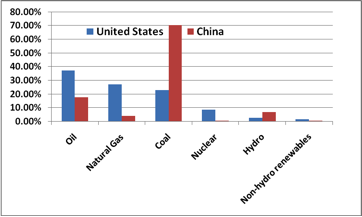China the Largest Energy Consumer and the Largest Coal Consumer
According to the recently released BP Statistical Review of World Energy, the United States ranked number one in 2010 as the largest user of non-hydro renewable technologies in the world, far above the next largest users—Germany, Spain, and China. The U.S. share of world renewable energy consumption was 25 percent in 2010, followed by Germany at 12 percent, and Spain and China with 8 percent each. The Obama Administration and others would like us to believe that the United is losing the race for so-called green technology to China, but the energy statistics for 2010 do not match the claims.
Source: BP Statistical Review of World Energy, http://www.bp.com/assets/bp_internet/globalbp/globalbp_uk_english/reports_and_publications/statistical_energy_review_2011/STAGING/local_assets/pdf/statistical_review_of_world_energy_full_report_2011.pdf
China consumed more energy than any other country in 2010 increasing its energy consumption 11.2 percent over its 2009 levels and consuming 20.3 percent of the world’s total energy consumption in 2010. It increased its coal consumption by 10.1 percent and accounted for 48.2 percent of the world’s coal consumption. Its consumption of oil increased by 10.4 percent and its consumption of natural gas increased by 21.8 percent, keeping China in its number one rank as the largest emitter of carbon dioxide emissions in the world. According to the BP statistical review, globally in 2010, carbon dioxide emissions grew at their fastest rate since 1969.
Other results from the BP statistical review for 2010 regarding the global energy system are:
Total Energy
- Total global energy consumption increased 5.6 percent, the largest rate of increase since 1973 with total energy consumption surpassing its previous peak reached in 2008.
- Energy intensity defined as energy consumption per unit of gross domestic product grew at its fastest rate since 1970.
Oil
- Global oil consumption grew at 3.1 percent, 2.7 million barrels per day, reaching a world record level of consumption at 87.4 million barrels per day. Oil consumption growth at 3.1 percent in 2010 was the largest percentage increase since 2004.
- China’s oil consumption grew by 860,000 barrels per day, 10.4 percent.
- Global oil production increased by 2.2 percent, 1.8 million barrels per day, lagging behind the increase in consumption. OPEC production increased by 960,000 barrels per day, 2.5 percent, and non-OPEC production increased by 1.9 percent.
- Growth in non-OPEC oil production was led by China, Russia, and the United States, each with an increase of over 200,000 barrels per day more than oil production in 2009. While the Obama Administration’s moratorium on offshore drilling caused lower U.S. offshore production, total U.S. oil production increased by 242,000 barrels per day, 3.2 percent, due largely to oil production increases from shale oil and shale gas liquids on non-federal lands.
Natural Gas
- Global natural gas consumption grew by 7.4 percent, the largest increase since 1984. The United States led the world in increased natural gas consumption due to low prices from shale gas production.
- Global natural gas production grew by 7.3 percent, with the largest increases in Russia, the United States, and Qatar. The United States remained the world’s largest natural gas producer with 19.3 percent of the world’s production followed by Russia with 18.4 percent.
- Liquefied natural gas shipments increased by 22.6 percent and commanded 30.5 percent of global natural gas trade.
Coal
- Coal consumption grew by 7.6 percent, the fastest global growth since 2003, and accounted for 29.6 percent of world energy consumption. China increased its coal demand by 10 percent, consuming 48.2 percent of the world’s coal demand, over 3 times the amount of coal that the United States consumed in 2010. The United States’ share of the world’s coal consumption in 2010 was 14.8 percent.
- Global coal production increased by 6.3 percent, led by China’s increase of 9 percent.
Hydroelectric power
- Global hydroelectric output increased by 5.3 percent. China is the world’s largest producer and consumer of hydroelectric power with a 21 percent share. It increased its hydroelectric output by 17 percent in 2010.
Nuclear
- Global nuclear output grew by 2 percent, with France’s output increasing 4.4 percent. France generates about 80 percent of its electricity from nuclear power.
Non-hydroelectric renewables
- Global biofuels production increased by 13.8 percent, 240,000 barrels per day, led by the United States (140,000 barrels per day) and Brazil (50,000 barrels per day).
- Global renewable power (non-hydrolectric) grew by 15.5 percent. Wind power increased by 22.7 percent with the largest increases in China and the United States, which together represented almost 70 percent of the growth. Non-hydroelectric renewables supplied 1.8 percent of total global energy consumption.
Comparison of Energy Consumption by Fuel Type, United States and China, 2010
(Share of Total Country Consumption)
Source: BP Statistical Review of World Energy, http://www.bp.com/assets/bp_internet/globalbp/globalbp_uk_english/reports_and_publications/statistical_energy_review_2011/STAGING/local_assets/pdf/statistical_review_of_world_energy_full_report_2011.pdf
Conclusion
2010 was a banner year for energy consumption in the world arena. All fuels saw increased consumption. China led the world in energy consumption and carbon dioxide emissions. China consumed over 48 percent of the world’s coal consumption in 2010, and increased its use of all fuels. While China is the world leader in wind capacity, its non-hydro renewable consumption represents only 8 percent of the world’s total. The United States ranked first in non-hydroelectric renewable consumption in 2010, consuming 25 percent of the world’s total. The United States is not losing the race for green technology, as these statistics clearly indicate. Its consumption of non-hydroelectric renewable energy was more than twice that of Germany and more than three times that of Spain and China, countries that ranked two, three, and four in non-hydroelectric renewable consumption in 2010.





